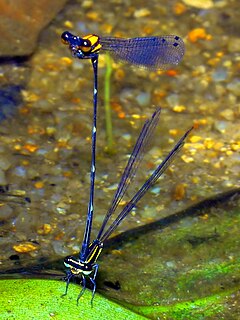
The Platycnemididae are a family of damselflies. They are known commonly as white-legged damselflies. There are over 400 species native to the Old World. The family is divided into several subfamilies.
Elattoneura caesia is a species of damselfly in the family Platycnemididae known commonly as the jungle threadtail. It is endemic to Sri Lanka, where it is distributed across the central and southern parts of the island. It lives in streams and springs in primary rainforest habitat. It is considered to be endangered because of the destruction and degradation of local rainforest habitat.

Elattoneura is a genus of damselflies in the family Platycnemididae.
Elattoneura cellularis is a species of damselfly in the family Platycnemididae. It is native to the southern half of Africa, where it is widespread from Angola to Mozambique. It lives in tropical rivers and streams.

Elattoneura glauca is a species of damselfly in the family Platycnemididae known commonly as the common threadtail and grey threadtail. It is native to the southern half of the African continent, where it is widespread. It lives in shady areas along rivers and streams.
Elattoneura leucostigma is a species of damselfly in the family Platycnemididae known commonly as the smoky-winged threadtail. It is endemic to Sri Lanka, where it is known from only one location. It has not been found in any recent surveys, and it is thought that it may have become extinct. It was known from streams in dense forest habitat, and the area has undergone habitat destruction and pollution of local waterways.
Elattoneura nigra is a species of damselfly in the family Platycnemididae known commonly as the black threadtail. It is native to Central Africa, where it is widespread. It lives along streams and rivers.

The Protoneuridae are a family of damselflies. Most species are commonly known as threadtails, while others are commonly known as bambootails.
Elattoneura frenulata is a species of damselfly in the family Platycnemididae known commonly as the sooty threadtail. It is endemic to South Africa, where it is known only from the Hawequas Mountains in the Western Cape. Though it has a restricted distribution, it is locally common. It lives near slow-moving rivers with abundant vegetation.
Troglocimmerites is a genus of beetles in the family Carabidae, containing the following species:
Elattoneura oculata is a species of damselfly in the family Platycnemididae known commonly as the two-spotted threadtail. It is endemic to Sri Lanka, where it is a rare species known from a few locations in the southern and central parts of the island. It lives along streams in primary rainforest habitat, an ecosystem threatened by habitat destruction and degradation.
Elattoneura centralis is a species of damselfly in the family Platycnemididae known commonly as the dark-glittering threadtail. It is endemic to Sri Lanka.
Elattoneura tenax is a species of damselfly in the family Platycnemididae known commonly as the red-striped threadtail. It is endemic to Sri Lanka.
Rualena is a genus of North American funnel weavers first described by R. V. Chamberlin & Wilton Ivie in 1942.

Elattoneura tetrica, black and yellow bambootail is a damselfly species in the family Platycnemididae. It is endemic to Western Ghats in India.

Elattoneura souteri is a damselfly species in the family Platycnemididae. It is endemic to Western Ghats in India.





